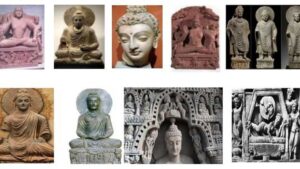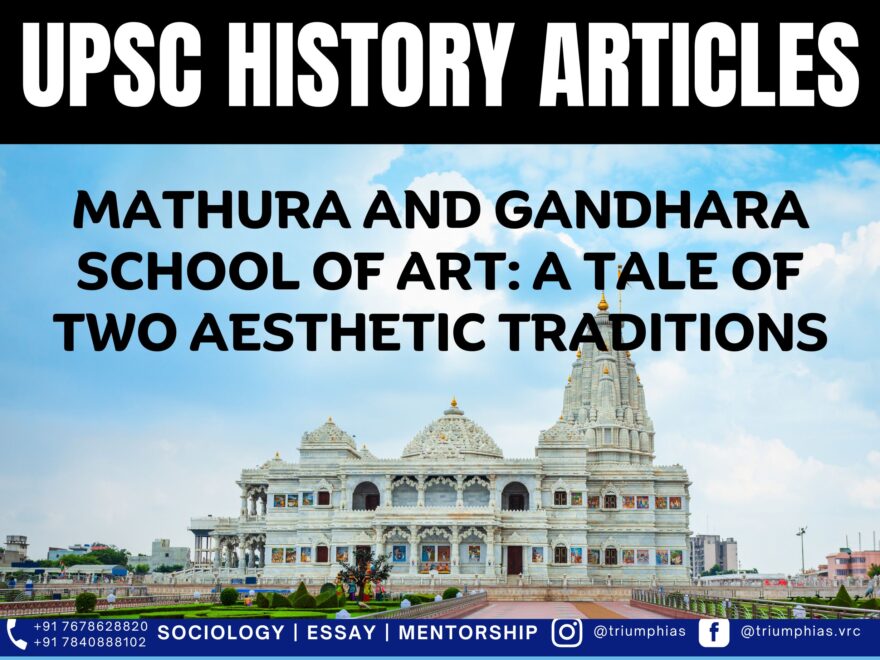Mathura and Gandhara School of Art
(Relevant for Historical Section of General Studies Paper Prelims/Mains)

Mathura and Gandhara School of Art
From the first century CE onwards, two significant centers of art production emerged: Gandhara, located in present-day Pakistan, and Mathura in northern India. Mathura and Gandhara, Buddha took on a symbolic form, transitioning from an abstract concept to a more human-like representation. The sculptural tradition in Gandhara was influenced by a fusion of Bactria, Parthia, and the local Gandhara tradition.
The local sculptural tradition in Mathura became exceptionally influential, extending its influence to other parts of northern India. An excellent illustration of this can be seen in the stupa sculptures discovered at Sanghol in the Punjab region.
The Buddha image in Mathura was crafted in a manner reminiscent of earlier Yaksha images, while in Gandhara, it bore Hellenistic features.
- In terms of geographical areas, the Gandhara school of art predominantly thrived in regions encompassing Afghanistan and the present-day North-western parts of India. Conversely, the Mathura school of art found its development and prosperity in Mathura itself and the surrounding areas of Uttar Pradesh.
- Regarding the time periods of these art schools, the Gandhara school of art reached its zenith from the first century BC to the fifth century AD. In contrast, the Mathura school of art originated in the first century BC and continued to flourish until the twelfth century AD.
- Influences from external sources set these schools apart. The Gandhara school of art bore the influence of Greek and possibly Macedonian artistic elements, while the Mathura school of art remained purely indigenous, devoid of external influences.
- Religious influences also played a significant role in shaping these art forms. The Gandhara school of art drew inspiration from Buddhism, while the Mathura school of art was influenced by Hinduism, Buddhism, and Jainism.
- Distinct materials characterized these schools. The Gandhara school of art primarily utilized bluish-grey and grey sandstone, while the Mathura school of art employed spotted red sandstone.
- Expression-wise, the Gandhara Buddha was known for its central theme of calmness. On the other hand, the Mathura Buddha exhibited a delighted mood, seated in Padmasana, with the right hand in Abhyamudra and the left hand resting on the left thigh, conveying a sense of masculinity.
- Halo decorations around the head of Buddha differed as well. Generally, Gandhara school of art didn’t decorate the halo extensively, while the Mathura school of art frequently adorned it.
The other two famous schools were Amaravati School and Sarnath School of art. All these art schools were mostly inspired by religion and have left behind a rich heritage. The Art of India constitutes a unique chapter in the history of human endeavour. It unveils the deepest recesses of the human mind and offers a mirror to the Indian soul. The spiritual and religious dimensions of India’s creative genius has found full and perfect expression in the myriad aesthetic creations.
Frequently Asked Questions:
-
Question: What were the geographical areas of influence for the Mathura and Gandhara schools of art?
Answer: Gandhara school thrived in regions of Afghanistan and North-western India, while Mathura school primarily influenced Mathura and surrounding areas in Uttar Pradesh. - Question: How did the religious influences differ between the Mathura and Gandhara schools of art?
Answer: Gandhara was primarily influenced by Buddhism, whereas Mathura was influenced by Hinduism, Buddhism, and Jainism. - Question: What materials were predominantly used in Gandhara and Mathura sculptures?
Answer: Gandhara sculptures used bluish-grey and grey sandstone, while Mathura sculptures employed spotted red sandstone. - Question: What external influences shaped the Gandhara school of art?
Answer: The Gandhara school was influenced by Greek and possibly Macedonian artistic elements. -
Question: How do the Buddha representations differ between the Mathura and Gandhara schools?
Answer: The Gandhara Buddha portrays a sense of calmness, while the Mathura Buddha exhibits a delighted mood and a sense of masculinity.
To master these intricacies and fare well in the Sociology Optional Syllabus, aspiring sociologists might benefit from guidance by the Best Sociology Optional Teacher and participation in the Best Sociology Optional Coaching. These avenues provide comprehensive assistance, ensuring a solid understanding of sociology’s diverse methodologies and techniques.
Mathura and Gandhara School of Art, Mathura School of Art, Gandhara School of Art, Indian Art, Buddhism, Hinduism, Jainism, Yaksha, Hellenistic Influence, Sandstone Sculptures, Padmasana, Abhyamudra, Amaravati School, Sarnath School, Stupa Sculptures, Sanghol
Choose The Best Sociology Optional Teacher for IAS Preparation?
At the beginning of the journey for Civil Services Examination preparation, many students face a pivotal decision – selecting their optional subject. Questions such as “which optional subject is the best?” and “which optional subject is the most scoring?” frequently come to mind. Choosing the right optional subject, like choosing the best sociology optional teacher, is a subjective yet vital step that requires a thoughtful decision based on facts. A misstep in this crucial decision can indeed prove disastrous.
Ever since the exam pattern was revamped in 2013, the UPSC has eliminated the need for a second optional subject. Now, candidates have to choose only one optional subject for the UPSC Mains, which has two papers of 250 marks each. One of the compelling choices for many has been the sociology optional. However, it’s strongly advised to decide on your optional subject for mains well ahead of time to get sufficient time to complete the syllabus. After all, most students score similarly in General Studies Papers; it’s the score in the optional subject & essay that contributes significantly to the final selection.
“A sound strategy does not rely solely on the popular
Opinion of toppers or famous YouTubers cum teachers.”
It requires understanding one’s ability, interest, and the relevance of the subject, not just for the exam but also for life in general. Hence, when selecting the best sociology teacher, one must consider the usefulness of sociology optional coaching in General Studies, Essay, and Personality Test.
The choice of the optional subject should be based on objective criteria, such as the nature, scope, and size of the syllabus, uniformity and stability in the question pattern, relevance of the syllabic content in daily life in society, and the availability of study material and guidance. For example, choosing the best sociology optional coaching can ensure access to top-quality study materials and experienced teachers. Always remember, the approach of the UPSC optional subject differs from your academic studies of subjects. Therefore, before settling for sociology optional, you need to analyze the syllabus, previous years’ pattern, subject requirements (be it ideal, visionary, numerical, conceptual theoretical), and your comfort level with the subject.
This decision marks a critical point in your UPSC – CSE journey, potentially determining your success in a career in IAS/Civil Services. Therefore, it’s crucial to choose wisely, whether it’s the optional subject or the best sociology optional teacher. Always base your decision on accurate facts, and never let your emotional biases guide your choices. After all, the search for the best sociology optional coaching is about finding the perfect fit for your unique academic needs and aspirations.
To master these intricacies and fare well in the Sociology Optional Syllabus, aspiring sociologists might benefit from guidance by the Best Sociology Optional Teacher and participation in the Best Sociology Optional Coaching. These avenues provide comprehensive assistance, ensuring a solid understanding of sociology’s diverse methodologies and techniques. Sociology, Social theory, Best Sociology Optional Teacher, Best Sociology Optional Coaching, Sociology Optional Syllabus.
Best Sociology Optional Teacher, Sociology Syllabus, Sociology Optional, Sociology Optional Coaching, Best Sociology Optional Coaching, Best Sociology Teacher, Sociology Course, Sociology Teacher, Sociology Foundation, Sociology Foundation Course, Sociology Optional UPSC, Sociology for IAS,
Follow us :
🔎 https://www.instagram.com/triumphias
🔎https://www.youtube.com/c/TriumphIAS
https://t.me/VikashRanjanSociology
Find More Blogs
|
Scope of the subject and comparison with other social sciences |
|||
|
|
|
|
Modernity and social changes in Europe |

